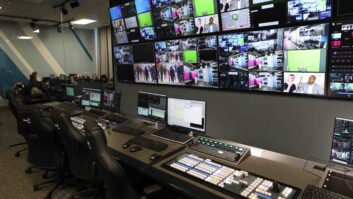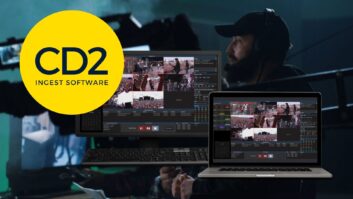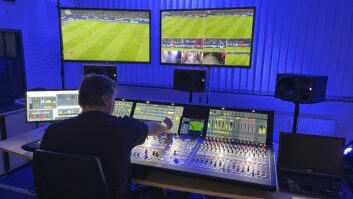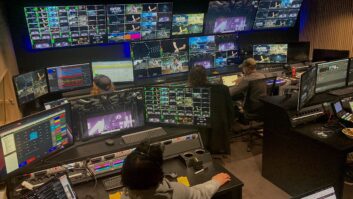
A convergence of technological, demographic, and economic trends is causing a tsunami-sized seachange in the global broadcast industry. Broadcasters across the world need to do more with less. Channel-in-a-box has become a popular Holy Grail solution, but real-world implementation is more difficult than what the channel-in-a-box marketing mythologies frequently claim. By Brian App, senior business development manager, Harris Corporation Broadcast Communications.
In developed nations, the internet offers new ways to access content and provides distinct advantages over terrestrial and cable/satellite broadcasting. Through streaming and file downloads, viewers can watch a wider variety of content according to their own schedules, instead of a broadcaster’s schedule, and with much shorter or no commercial breaks, and little or no subscription fees. And, the affordability of laptops and prevalence of WiFi mean content is even available outside of the home.
However, due to the cost of Internet access, the technical knowledge required to use it, and lower picture quality, Internet content consumption is not yet the norm. Many viewers in developed nations still watch content over the air or through cable/satellite, and most countries still broadcast in both HD and SD. Although IPTV is definitely the future, until the majority of viewers have switched over to IPTV, broadcasters must continue to broadcast through HD/SD terrestrial and cable/satellite. This necessity to broadcast in multiple mediums combined with increasing energy costs will continue to drive up the total cost of distributing content.
Despite these rising costs, advertising revenue for television is trending downward. DVRs allow viewers to fast-forward through commercials. Competing mediums such as the internet and digital signage more effectively target specific demographics and provide more accurate ROI data. Digital signage can also target audiences when they are more attentive (e.g., while riding public transportation). Advertising dollars will continue to migrate to other mediums over the next decade, so the downward trend in television advertising revenue will persist.
In contrast, the broadcast industry is booming in developing nations. However, equipping a new channel is difficult as advertising dollars are often in local currencies, and most major broadcast equipment manufacturers are based in developed nations with significantly higher currency values.
In light of these trends, the current approach for equipping a broadcast channel is becoming too expensive for the available revenue — in both developed and developing nations. Channel-in-a-box is a potential solution to this problem. By reducing the amount of equipment and streamlining workflows broadcasters can theoretically distribute content in more formats at lower costs through less energy consumption and real estate, and fewer work hours. However, although advancements in information technology (IT) have made a channel-in-a-box solution technically feasible, reducing the complex requirements of modern broadcasting into a handful of computers still presents many challenges that few companies can adequately handle.
Key considerations
In the past, analogue signals and inadequate PC hardware meant dedicated hardware was necessary for each stage of the broadcast workflow. Today, recorded video is increasingly stored and distributed in digital files or transported to transmitter sites and cable/satellite facilities via IP streaming, so working in baseband inside the broadcast facility is not always required.
Also, the computer industry has steadily increased available processing power to the point where dedicated hardware is not always necessary. PC architecture provides raw, generalised processing so many disparate tasks are possible on the same device without requiring hardware changes or reconfiguration. Generalised processing power also allows more industries to use the same hardware, reducing the total manufacturing cost through increased economy of scale.
However, hardware processing is still needed. Many tasks in the broadcast workflow (e.g., advanced encoding or resizing video) are very resource intensive, and high definition, particularly 1080p, requires lots of processing power for even the most basic tasks. Cable, satellite and terrestrial broadcasters need to maintain high quality to give them a competitive advantage over IPTV, so high compression (and the resulting decrease in quality) is not an option. The only real solution is to offload some tasks to dedicated hardware, but very few channel-in-a-box companies have the necessary hardware intellectual property.
A true channel-in-a-box solution should not drastically reduce capabilities. Each part of the broadcast chain has evolved over 20-50 years. As a result, video, graphics, processing, editing, automation, sales and traffic all have unique and complex requirements. Few channel-in-a-box companies have the necessary end-to-end broadcast expertise to adequately address these requirements, and developing the intellectual property from scratch would take over a decade even for a large, dedicated development team.
An in-depth look at a company’s offering reveals its existing expertise and intellectual property. If the company comes from an automation background, its products have stronger automation features, but weaker video, processing, editing and graphics. If the company has no background in broadcast, then every piece of the puzzle is weaker and the resulting workflow seems cobbled together. An efficient, robust, end-to-end workflow is critical to a successful channel-in-a-box solution. Only a company that has an understanding of the detailed requirements of every piece of the puzzle — and how the pieces fit together — can succeed at providing broadcasters with a viable solution.
Finally, the current approach to broadcast is not going away. Live broadcasts such as elections, sports and news add a level of complexity that makes a channel-in-a-box less practical — they still require multiple human operators, have differing and more demanding workflow requirements and make unpredictable system demands. However, standardising on common editing, graphics and digital asset management platforms can introduce cost-saving efficiencies, so choosing a channel-in-a-box solution from a company that also offers full solutions for live broadcast has significant advantages.







